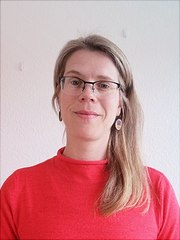21/11/23 - Cornelia Loos (University of Hamburg)
Title: "Who’s going the distance here? Fictive motion in sign languages"
Visual manifestations of an object moving through space are common in sign languages, which can represent such motion either factively or fictively. Fictive motion encompasses techniques that convey the movement of an object via a second object that is factively immobile yet is represented as if it were moving (Talmy, 1996). To give an example, signers frequently depict a person driving fast along a road by showing how the trees fly by them. Each arm and hand represents a tree and the hands are repeatedly moved past the signer’s head. Now, the trees don’t factively move, but their fictive motion indicates that the (person in the) car is traveling a wide distance at a fast pace. In this talk, we will look at examples of fictive motion as attested in the sign language literature and poetry of seven different sign languages. We’ll discuss which anatomical and cognitive-perceptual factors motivate their co-occurrence with classifier constructions and constructed action, and we’ll look at cases that are not attested in spoken languages, namely combinations of factive and fictive motion in one sentence.

